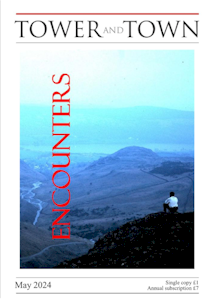

Tower and Town, May 2024 (view the full edition) (view the full edition)Ur at the Golden Age of TravelIt was 19th century steam that triggered the Golden Age of Travel from around 1880 up to the cataclysm of WWII. For the first time travelling for leisure became possible via luxurious trains and ocean liners. Hence, luxurious trains were first introduced in the USA by the Pullman Company in 1867, and later inspired European developments leading to the maiden voyage of the Orient Express in 1883. 1. Encounter in London It was in the spirit of that age that in Autumn 1928 a notable lady visited the offices of Thomas Cook & Son on Ludgate Circus, London, seeking a holiday after finalising her divorce in October. She bought tickets for sailing to the West Indies; however, two days before her departure an encounter in London set her on a new life trajectory. The lady considered it Fate that a casual meeting with a couple at a dinner invitation filled her with enthusiasm to visit Baghdad and Ur in Iraq on the Orient Express from Victoria Station. After all, Ur was a place she was thrilled to read about in the Illustrated London News archaeology dispatches of Leonard Woolley, (1880-1960). Next morning she rushed back to the Cook's office to cancel her West Indies booking, and to book instead for the Simplon-Orient Express to Istanbul; from Istanbul to Damascus; and from Damascus to Baghdad across the desert using motor transport, (Nairn Company). Thus began the fascinating association of Agatha Christie, (1890-1976), with the Near-East. 2. Encounters at Ur of the Chaldeans Agatha Christie was welcomed at Ur by the archaeologist Leonard Woolley and his wife Katherine, and the experience inspired her to write "Murder in Mesopotamia", and to express her sentiments: 'I fell in love with Ur, with its beauty in the evenings, the ziggurat standing up, faintly shadowed, and that wide sea of sand with its lovely pale colours of apricot, rose, blue and mauve changing every minute.' One of the first true cities in the world, Ur is about 160 km northwest of the modern city of Basra, southern Iraq. This site has been known to the British Museum since 1854, and it was chiefly excavated by Sir Leonard Woolley between 1922 and 1934 funded by the BM and Pennsylvania University. Interest in this city continues as the archaeological findings attest - from thousands of inscribed clay tablets from the period of Abraham, a picture of Ur in his day can be reconstructed. Moreover, enough evidence exists to suggest that Abraham's Ur also had skilled engineers, architects, knowledgeable farmers and artisans, as well as celebrated jewellers. The achievements of the latter graced many a citizen. Indeed, royal graves of Ur from 500 years prior to Abraham's time have yielded a stunning array of art objects of gold and precious stones. Dominating the city, both physically and spiritually, was the temple-tower or ziggurat which rose in three stages to one hundred and fifty feet above the streets. Dedicated to the moon God Nanna, the ziggurat was constructed at Ur at around 2100 BC by Ur Nammu, styling himself 'King of Sumer and Akkad'. Even in its ruinous and current restoration states, it is an imposing sight. For Agatha, Ur merited a second visit during the spring of 1930 when she met the young archaeology apprentice, Max Mallowan (1904-1978), who was away during her first visit. They shared their passion for the past, and their encounter is now legend within Mesopotamian archaeology. Agatha and Max married in Edinburgh in1930, aged 40 and 26 respectively. In addition, Max's passion for his work soon paid off by earning a professorship at London University, a knighthood, plus in 1947 1st directorship of the British School of Archaeology in Iraq, (BSAI). Agatha accompanied Max on many excavations, including Nineveh and Nimrud in northern Iraq, where she helped in preserving and photographing artifacts such as the Assyrian Ivories discovered by the team of BSAI at the bottom of wells in Nimrud. But soon the age of flight arrived, and the Orient Express was no longer economical. Then a day came when Dame Agatha and Sir Max found themselves departing their excavations on a Mediterranean ship. Agatha stood by the rail of the departing ship, looking back at the dim blue mountains of Lebanon as they receded into the distance. Max asked what was on her mind as nearly ten years of writing, travelling, and digging together came to an end. 'I am thinking', she said, 'that it was a very happy way to live.' https://c8.alamy.com/comp/ce5t22/ziggurat-of-ur-of-the-chaldees-ancient-sumerian-site-in-southern-iraq-ce5t22.jpg Raik Jarjis |